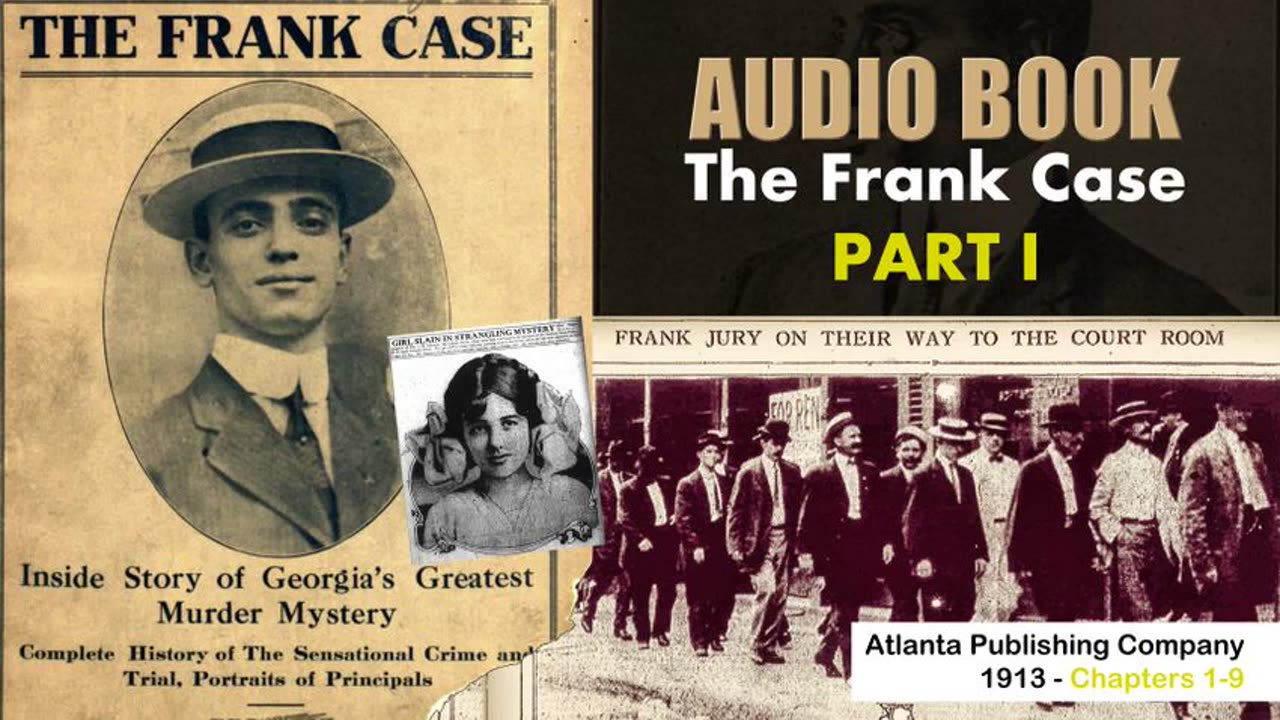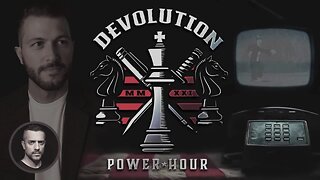Premium Only Content

The Leo Frank Case - 1913 Part 1 Chapters 1-9
The Frank Case is Georgia's premier crime thriller and the story of a young Mary Phagan who is murdered while collecting wages at the National Pencil Factory. Leo M. The Frank case ended with the arrest of Frank, the manager of a large factory where an employee died. The story of the case, the highlights of the next four months, and the main trial, in which two of the South's leading criminal lawyers fought the Atlanta attorney general's decision to spare Frank, were covered in the press. Frank will be sentenced in Fulton Superior Court, but a new trial has been filed and a possible death sentence could still be months away. The most important details in this document are the events leading up to the trial of Leo M. sincere.
At 3am on April 27, Mary Phagan's body was discovered in the basement of the National Pencil Factory. At noon, the night watchman, Newt Lee Negro, arrives. Arthur Mullinax was arrested and blood was found in a metal room on the second floor. Coroner Donahue empanels a jury and closes the inquest. JM Gant is captured and Pinkerton is tasked with finding the hunter. Frank and Lee were taken to the county jail and held there pending the medical examiner's decision. Attorney General Dorsey intervenes and Frank details his actions on the day of the murder. Paul Bowen is arrested and released after his alibi is discovered. Frank and Lee are being held by the coroner's grand jury. Mrs. Frank visits her husband for the first time since his captivity. Colonel Thomas B. Felder reports that Detective Burns is working to solve the mystery. May 21 - New York fingerprint expert P.A. Flack said the findings were unclear. May 24 - Conley shockingly reveals that Frank tricked him into writing the body text. 05/26 - Authorities in Burns announce that the investigation is closed.
May 27 - Conley also makes the surprising claim that Frank helped move Mary Phagan's body into the basement. Season 3 - Minola McKnight prepares a surprising statement when she hears about Frank's strange behavior on the night of the murder. June 7 - Mrs. Frank reprimands Attorney Dorsey and explains that the room where Minola McKnight made her statement was a torture chamber. June 8 - Attorney Roger charges Chief Lanford with murder. June 23 - Attorney Dorsey discovers that night watchman Newt Lee was awakened by a clock on the second floor of the National Pencil Factory.
A shadow dances in the corner towards him as he reaches out to warm the glass of the lamp. The lamplight reflected the face of a large clock that chimed every half hour. Soon Newt will be patrolling abandoned factory buildings, ringing bells and sitting back and relaxing. He was so tired that he thought he should rest.
Newt worked as a night watchman at a factory for several months. He was tired, but his tutor, Mr. Frank allowed him to rest in the afternoon. As he nears the bottom of the stairs, he shines his flashlight back and forth across the empty space on the first floor and grunts. Haya falls at 3 am. At 6 o'clock Mr. Frank told him to slow down and not come back until 6 o'clock. Newt stared at the main floor in silence as usual. There were no busy workers, no men eager to pick up a pencil, no dozens of factory girls standing by the machines. He likes cars. Because for a night watchman, peace means safety in everyday life. If you go to another floor, you will find yourself in the darkest darkness, the basement. As Newtree lifted the hatch above the water, a faint light shone from within. His lamp dimmed the cellar's dim light and flickered with light. Each time he turns, he slowly raises his legs as the flashlight moves its light back and forth, brightening the dim basement light a little. His feet were on the ground and the flashlight gave off a yellow light when he was in the basement. He takes three steps and stops. The lights came on, illuminating a pile of clothes and items Newt had never seen before. Her heart was pounding and she tried to smile, but her voice was hoarse in the silence. Newt Lee took another step forward, then stumbled back as the flashlight flickered again. When he saw that he was blocked like an ice dam, he jumped up and cried and went up the stairs. Newt was patrolling the factory building when the bell rang. The opening hours meant that the office's large printing press would print several pages for the villagers to occupy between Sunday breakfast and church. They broke away from the throngs of jovial, laughing blacks who had gathered hours before and reached the foggy streets of Decatur. Brit Botts was in Rogers' car and a third reporter stayed in the car. Inside the station building, the employees sat on chairs and spent the rest of the day until dawn. A thin point of light appeared on the smoky eastern horizon, and the hands of the station clock showed 45 minutes. The officer, who was charged with disorderly conduct, heard a black man crying in a cell behind the station that evening. The sergeant called to the burly man standing in the doorway, holding a chevron symbol that announced itself to the troop. When the phone rang, Mr. Boots' representative, Mr. Rogers, took the floor and began a heated conversation about Grace's case. V.T. Anderson got up tiredly, went to the phone booth door and opened it.
The Headmaster brothers looked up with interest for a moment, then returned to their seats. Then he got a message from a black man several streets over. A black man spoke with the trembling voice of a dead girl found in the basement of the National Pencil Factory on Forsyth Street. When Officer Anderson sent a message from the phone booth, the sleeping officers jumped and woke up. They got into the car, woke the sleeping reporters, and drove to the corner of Pryor and Decatur streets. On the corner stood two men, Officer Dobbs and Brown. The car slowed down and four people got out. Officer Anderson slammed his fist on the door and Newt Lee's horrified face looked up at them. They opened fire on him and entered the dimly lit factory gate. Lee led the way and Anderson followed, revolver in hand. Newt Lee anxiously led them up the stairs into the darkness, pointing to something in the corner. The officers bent down and saw the girl's horrified and mutilated body. The head was forward and the foot on the right rear. His face was bruised and black with dirt. When the men bent down to examine them more closely, the most important detail in the document was that they found two dirty yellow pieces of paper on which someone had scrawled a crude note. The officers read notes written by Lee and the tall black man who pushed him into the well. Anderson suddenly turned to the security guard and slapped Black on the shoulder with a rough hand, accusing Black of doing it. Police later contacted Mr. Brown, who conducted a thorough search of the basement and found the girl's other slippers. Later, the police found two sheets of dirty yellow paper with someone's crude writing on them. Anderson suddenly turned to the security guard and slapped Black on the shoulder with a rough hand, blaming Black. Newt Lee was arrested Saturday morning on suspicion of murder and taken to the police station to identify the dead boy. Grace Hicks, who lives at 100 McDonough Road, accompanied Rogers to P.J.'s morgue. Bloomfield saw the mutilated body of Mary Phagan. Detective Stearns called Frank, the property manager, and told him what had happened at the factory and that he was going to pick him up. While the police and investigators were on the scene, Detective Stearns called Frank, his house supervisor, and told him that something had happened at the plant and that he was going to arrest him. Rogers and Detective John Black go to Frank's house and ask him what happened to the pencil factory.
Frank is dressed except for his collar and tie and looks very nervous. On the way, Black Frank asks if he knows a girl named Mary Phagan, and the factory manager tells him to check the factory payroll. On their way to the factory, the three stop at a funeral home to view Mary Phagan's body. By sunrise, word of the crime had spread throughout the city, and plant manager N.W. Several people, including N.W. Darley, they were standing outside the factory gate.
Frank greeted the principal and officers and went to Frank's office. When the inspector opened the safe, he found a blank book with the name Mary Phagan. Frank asked if there was any evidence of wage turnover in the factory. The next request was to know where the girl's body was found. Frank went to the control box next to the elevator, unlocked it, and turned on the machine. Back downstairs, someone suggested we all go to the station building, where Frank suggested we take a key out of our pocket and open the locked door on the right. Boots Rogers later said that Frank took a key from his pocket, opened the right side and produced the Timeslip magazine. An important detail in the document is that Frank found a pencil in one of the holes and asked Lee why the pencil was there. Frank takes out his watch and writes on the side of his briefs April 26, 1913. Frank sits on Dali's lap at the police station, shaking violently. At the police station, Frank said that a man named J.M. Gantt went to the factory Saturday morning. Gant was the young man who had just left the factory and returned in the afternoon with the shoes he had left behind. Based on this statement, the Department of Criminal Investigation began to search for Gant. Detectives impounded Newt Lee Frank's home while they searched for more suspects. Mary Phagan was a factory girl who worked hard from dawn to dusk. On Memorial Day, he went downtown to see the Confederate veterans marching down Peachtree Street.
He took a tram into the city and met George Epps, a journalist he had always admired. He promised to meet her at 1 pm. I saw guys in gray walking down Marietta and Forsyth streets. That evening, George Epps ran to the heathens to find out why Mary had not met him as she had promised. Mary's stepfather, J.W. Coleman, went into town to see if he could find Mary. There she would have attended the Beauty Theater with her friends.
The most important details in the audio file are the events leading up to Mary Coleman's death. Mr. Coleman went to Bijou and found her face flowing, but he never saw the face of the little girl he was looking for. He returned to their home on Lindsey St. 146 and comforted her mother, who was distressed at the thought of Mary Marietta visiting her grandmother. On Sunday, April 27, Phagan knocked on the family door and told his mother it was a message from Mary. At the door stood her neighbor, Miss Helen Ferguson, her eyes full of pain and her lips barely able to say the terrible things she wanted to say. Word reached the Phagans and Mr. Coleman rushed to the village to find the girl's body, which had overtaken her daughter. In Bloomfield, undertaker Will Geesling showed him the body and it was positively identified as an elderly man. Later in the scene, hundreds of people are seen staring at the blank walls of a pencil factory. Mary Phagan was murdered on April 29 in the basement of the National Pencil Factory in Atlanta, Georgia. He is buried in the old family cemetery in Marietta, Georgia, 32 miles from Atlanta. The body was exhumed on May 7 by order of the prosecutor's office, and doctors conducted a thorough examination of the stomach and other vital organs. HF Harris was administered by the state Department of Public Health. The murder of Mary Phagan and the mystery surrounding her brutal murders created a sensation and remained a mystery not just for nine days, but for months. Mary Phagan's name was on everyone's lips and by Monday morning, the day after the murders, several newspapers appeared. The Atlanta Police Department was flooded with rumors that led to the discovery of the killer. The first public opinion unanimously convicted Newt Lee, but reports of other suspects led to the arrest of Arthur Mullinax, a former streetcar conductor and friend of the dead girls. Mullinax was arrested based on the testimony of C.J. Camper Food Company employee E.L. Sentell. Sentell said he had known Mary Phagan for years and was convinced she was the same girl he saw on the street. Mullinax was briefly detained by police and then taken to the police station on Sunday evening. Important details from this document reveal the fact that the two suspects, J.M. Gantt, Lee, and Mullinax. It is understood Mr. Gantt knew Mary Phagan and was at the factory on Saturday afternoon. He worked in the factory so he knew the building well. Gantt's sister, Mme. F.C. Terrell was found by police at his home at 284 East Linden Street and gave conflicting accounts of his actions. The officers decided they were on the right track and arrested Mr. Gantt for Mary Phagan's murder. Gantt flew to Atlanta and joined Lee and Mullinax at the train station.
Two police officers appeared on a Decatur street, far from the crowd of cheers and laughter that had engulfed them hours before. They found Britt in Boots Rogers' car while a third reporter stayed in the car. In the station building, employees sleep on chairs during the day until dawn. As the station clock strikes 45 minutes, a thin point of light appears on the smoky eastern horizon. Officer Anderson receives a text from a black man telling him about a dead girl found a few blocks away in the basement of the National Pencil Factory on Forsyth Street. When Anderson heard this, he ran out of the phone booth and woke up the sleeping police officers. If an emergency occurs, the machine will be operational within a minute. Police were seen at the corner of Dobbs and Brown Prior streets and Decatur streets as a National Pencil Company vehicle approached. When the four men got out of the car, Officer Anderson balled his fists and slammed the door. Newt Lee pointed to the corpse in the corner and led them up the stairs into the darkness. Police found her broken hair, black hair covered in blood from a heavy blow to the back of her head, crisp white hair, a bunch of faded and stained blue ribbon, and blood on her lavender silk dress. I noticed that the white slipper was still hanging from his right foot. The most important detail of the document is that two dirty, yellow pieces of paper were found with someone's scribbled scribbles on them. These letters were written by tall colored people and employed by tall colored people. The officers read the note and decided that the person who wrote it had committed this infernal act. Police later found the girl's other slippers, a small, thin hat, and two sheets of dirty yellow paper on which someone had written a rude letter. Newt Lee was arrested and taken to the police station, where the deceased boy was identified. The sentence ends with the announcement that an investigation has begun into the murder of a small factory worker.
Two policemen appeared on a street in Decatur, breaking away from the cheering crowd and laughing at the blacks who had swept them a few hours earlier. They found Britt in Boots Rogers' car while a third reporter stayed in the car. In the station building, employees sleep on chairs until the sun comes up. The station gauges mark 45 minutes and a thin, bright spot appears on the smoky eastern horizon. Officer V T. Anderson receives a report from a black man that a young girl has been found dead in the basement of the National Pencil Factory on Forsyth Street, a few blocks away. When Officer Anderson took the message from the phone booth, the sleepy officers jumped and woke up. If an emergency occurs, the machine will be operational within a minute. Officers Dobbs and Brown were seen at the corner of Prior and Decatur streets as a National Pencil Company vehicle approached. When the four men got out of the car, Officer Anderson clenched his fist and slammed the door. Newt Lee pointed to the corpse in the corner and led them up the stairs into the darkness.
Officers saw her broken hair, black with blood from a severe blow to the back of her head, distinct white hair, a blue ribbon that tied her, faded and stained, and she was wearing a lavender silk dress. Covered in blood. He had a white slipper on his right foot. The most important detail of the document is that two dirty, yellow pieces of paper were found with someone's scribbled scribbles on them. This post was written by a tall black man employed by a tall black man. When the policeman read the ticket, it became clear that the person who wrote it had committed this heinous act. Police later found the girl's other slippers, a small, thin hat, and two sheets of dirty yellow paper on which someone had written a rude letter. Right after Newt Lee was arrested, he was taken to the police station to find out who the dead boy was.
Officer Rogers told the officers that he knew the girl who worked at the pencil factory and could guess who the murdered boy was. Grace Hicks, of 100 McDonough Road, accompanied him to the mortuary where P.J. Bloomfield's body was laid to rest. Detective Starnes called Frank, the doorman, and told him to get his jacket and come with him. On the way, Black asked Frank if he knew a woman named Mary Phagan, and the factory manager said he would check the factory payroll.
On their way to the factory, the three stop at a funeral home to view Mary Fagan's body. When asked if he knew his friend, Frank said he could always find him by visiting the factory. As the sun rises, the three approach the factory and word of the crime spreads throughout the city. Among them is factory manager NV Darley, who asks Frank to inform his wife before leaving home. Frank greeted the field manager and entered Frank's office with the chief and officers. When the inspector opened the safe, he found a blank book with the name Mary Fagan. Frank asked if there was any evidence of wage turnover in the factory. The next requirement of the investigator was to examine the place where the girl's body was found. Frank went to the control box next to him to unlock the elevator, turned on the machine and the elevator began to descend. The group went through the basement where the body was found and returned to the second floor. Frank has known Darley for a long time and said that if he could get anything from him, it would be Darley. When we got back to the ground floor, someone told us to go down to the station building. Frank turned to Darley and asked him to write another note on the clock. Botts said Rogers rarely mentioned the murders and that he saw the area where Mary Fagan was found dead. When I told Darley about the new clock problem, the director agreed. Frank took the key out of his pocket, opened the locked door on the right and took out the time sheet. While looking through the notes, he found a pencil in one of the holes and asked Lee why the pencil was there. Black put the pencil there so he wouldn't make the mistake of making the right hole. Frank unlocked the watch and wrote "26". It is at the end of the "April 1913" section. Frank and the police board Roger's plane, and Frank sits on Darley's lap. At the police station, Frank nervously jumps out of the car and speaks quickly and slowly. Frank J.M. A young man named Gant, who had just been released from the factory, came to the factory on Saturday morning and returned in the afternoon with the shoes he had left behind. Based on that statement, the Department of Criminal Investigation issued a search warrant for Gantt. Detectives impounded Newt Lee Frank's home while they searched for more suspects. Mary Fagan was a factory girl who worked hard from dawn to dusk. On Memorial Day, he drove downtown and picked up $1.20 from the factory. He took a tram into the city and met George Epps, a journalist he had always admired. They got into the car together and Mary arranged to meet him at 1 a.m. At twelve o'clock that evening, George Epps rushed to Fagan's house to find out why Mary had not met him as she had promised. Mary's foster father, J.W. Coleman, went into town to see if he could find Mary, who may have gone to the beauty theater with her friends. Mrs. Coleman's husband, Mr. Coleman, goes to the Bijou and watches people pass by, but never sees the face of the girl he's looking for. He returned to their home on Lindsey St. 146 and comforted her mother, who was distressed at the thought of Mary Marietta visiting her grandmother. On Sunday, April 27, there was a knock at Fagan's door, and his mother's heart skipped a beat when she said it was a message from Mary. My neighbor, Helen Ferguson, was standing at the door. His eyes were sad and his mother's heart was broken. Word reached the Phagans and Mr. Coleman rushed to the village to find the girl's body, which had overtaken her daughter. In Bloomfield, undertaker Will Geesling showed him the body, which he positively identified as an old man. The scene later showed hundreds of people staring at the blank walls of the pencil factory. The most important details in the document are the events surrounding the murder of Mary Phagan, a girl who was murdered in the basement of the National Pencil Factory in Atlanta, Georgia. On April 29, the girl's body was buried in the old family cemetery in Marietta, Georgia, 52 miles from Atlanta. On May 7, his body was exhumed at the direction of the prosecutor's office, and doctors carefully examined his stomach and other major organs. HF Harris was administered by the state Department of Public Health. The results of the investigation were known only to him and his lawyer until he took the witness stand nearly three months later. This crime shocked the city of Atlanta like never before. The Grace incident was a sensation that lasted for months, not just nine days. The murder of Mary Phagan and the mystery surrounding her brutal murders created a sensation and remained a mystery not just for nine days, but for months. Newspapers continued to circulate Monday morning, the day after the murders, and the Atlanta Police Department was flooded with rumors, many of which led to the discovery of the killer. The first round of public opinion unanimously convicted Newt Lee, but reports of other suspects led to one more arrest before the end of the first on Sunday. Mullinax was briefly detained by police and placed in a separate cell. Another suspect, J.M. Gantt was arrested Monday in Marietta. He knew Mary Phagan and is known to have been at the factory on Saturday afternoon. Mrs. Gantt's sister, Madame F.C. Terrell was found by the police at his home at 284 East Linden Street and gave conflicting accounts of Mrs. Gantt's movements. Officials then decided they were on the right track. Gantt was arrested Monday morning on a warrant for Mary Fagan's murder. He was transported to Atlanta and joined Lee and Mullinax at the station. Gant was honest about the fact that he had been laid off from his factory job a few weeks earlier and had returned to Marietta to buy shoes. The morning after his incarceration, Gant tried to get out of jail by filing a writ of habeas corpus, but he and Mullinax were released before the warrant took effect. Both men presented a clear alibi through testimony at a forensic inquest on May 1.
Police and investigators were outraged by rumors that the girl had been kidnapped and drugged. Paul Bowen, a former Atlanta boy who knew Mary Fagan, was arrested in Houston, Texas, and provided an alibi on May 7, the day after his arrest. Police got a helping hand on Monday when it was revealed that officials at the pencil factory had asked local Pinkerton detectives to help investigate the crime. On Monday, April 28, the jury met Coroner Paul Donoghue in the metal-armored pencil factory room. The discovery of bloodstains on the floor of the metal room led investigators to suspect that Fagan's daughter had been killed there, rather than in the basement as originally suspected. On Tuesday, April 29, Leo M. Frank, president of the National Pencil Factory, was taken to the police station and arrested for the murder of Mary Fagan. From that day he was never free. The most important information in this article is that the suspect was born in Paris, Texas in 1884 and moved to Atlanta when he was 3 months old. He attended Brooklyn Public Schools and Pratt Institute in Brooklyn. He earned a degree in mechanical engineering from Cornell University in 1902. Then he started working as an artist with a friend.
We are a trusted company located in High Park, M.A. Six months later, he returned to his hometown of Brooklyn to work as a test engineer and draftsman for the National Meter Company in Brooklyn, New York. He remained in this position until the middle of October, 1907, when he came south to consult with the citizens of Atlanta regarding the establishment and operation of a pencil factory there. At 11:45, Newt Lee said he arrived at the factory at 4 p.m. He left following Frank's instructions. Detectives and police said she was lying face down, but he said he saw her face up. J. G. Spirit said he saw a girl and a man outside the Cartersville Pencil Factory Saturday afternoon. George Epps said Mary told him Mr. Frank winked at him and said he was suspicious. Sentell said he saw Mullinax with a girl he believed to be Mary Fagan on Saturday night. R.P. Barrett said he noticed bloodstains near Mary's equipment on the second floor. This indicates that she began her fight for her life there, and not in a dark basement. Gantt and Mullinax were released Thursday afternoon and an autopsy was temporarily postponed.
Investigators concluded that young Mary Phagan made a brief visit to the factory on Saturday afternoon to collect wages and never left the factory. This left investigators scrambling to solve the mystery of the girl's death. I went one step further. Elle Sentell admitted that she met Pearl Robinson with Mullinax and not Mary Phagan. Other witnesses who claimed to have seen the girl on Saturday afternoon also came forward and said they may have been wrong. The problem was solved and the authorities were given reason to believe that Mary Fagan never left the pencil factory alive. Newt Lee and Leo Frank were transported to the Fulton County Sheriff's Office pending investigation by police headquarters. 2 suspects, Leo M. Frank and Newt Lee were taken to the Atlanta Tower amid questions about the legality of their arrests on municipal warrants. The verdict that brought them to the Tower was identical in all but name. The police arrested and kept Leo M. Franks, a suspect in Mary Fagan's murder, in custody at the Fulton County Jail in Georgia. He read that Frank should be arrested and detained pending further investigation. Mary Fagan has announced her death. After the two men in the tower and two other former suspects were released, investigators seemed to have no doubt that they held the key to solving the mystery. However, there was another man involved in this and his arrest was not much talked about at the time, with the newspapers only writing a paragraph about it. This man later shocked the world with the most shocking testimony before the trial. James "Jim" Conley, a black janitor who worked at the National Pencil Factory, was arrested at 2 a.m.
He was arrested as a suspect along with Lifter Snowball around 12 p.m. on Thursday at the police station factory. Investigators arrested a sixth suspect in Fagan's slaying at 1 a.m. At midnight Thursday, Conley was seen washing shirts in a faucet behind the building. He said his shirt had rust stains and he had washed it to attend the coroner's inquest when he was called. Suspects and clues flooded the detective agency, and many of Frank's friends investigated the case privately, hoping to dispel the cloud of suspicion hanging over the famous young detective. He was a prominent figure in the community and popular with his friends. He was president of a local Jewish organization, a church and welfare leader, and a college graduate. Mary Fagan's friends encouraged her when she was charged with murder. People called officers to tell them what to do, and hundreds of letters poured in from all over the state and six other states. Two women who had nightmares about the murder accurately described the killer. When detectives revealed that they honestly believed either Frank or Lee were the culprits, tempers soared and people were expecting something nasty to happen on Thursday night. City, county and public officials were also carefully considered. Governor Joseph M. Brown advised Lt. Gen. J. Van Holt Nash to contact the 5th Georgia Regiment of the Georgia National Guard to prepare for an emergency. AND AND. colonel Pomeroy, the commander of the 5th Regiment, gathered his men in the armory of the auditorium, a few blocks from the tower where Frank and Lee were confined, and kept them there late into the night. At 11:30, the soldiers were allowed to return home. Rumors of mob violence were unfounded until the coroner's jury reconvened Monday morning. Early Saturday morning, defense attorney HM Dorsey held a lengthy conference call with Detective Ranford and Coroner Paul Donoghue, which led to more witnesses being called in the investigation and city and state police joining forces in the case. I decided to work on it. A new Fulton County grand jury found W.D. Monday morning. Eris cursed. The judge reminded the coroner's jury that they must review Fagan's case before convicting them of Mary Fagan's murder. The first witness was Leo M. Frank took the stand for three and a half hours, talking about where he was and what he was doing on the day of the murder.
Other witnesses examined that afternoon included Mr and Mrs S. Emil Selig of the Franks. Frank initially lived in Brooklyn, New York, and left Brooklyn in October 1907 to return to the United States to work for the National Pencil Company, where he became general manager. Frank was responsible for managing material purchases, controlling factory costs, entering and fulfilling correct orders, and overseeing overall production. On Saturday morning, I went to work at the factory as usual, and in the afternoon, I did the same work as usual. No one was in his office when he started copying and sending orders.
At 12:10, 12:05, the murdered girl came to get the envelope. Frank was in the office processing an order when he came in and asked for an envelope. She handed him the envelope with the payment, knowing he would take it. The most important information in the audiobook is that the witness Frank had money in his wallet to avoid going to the safe and did not know Mary Fagan's phone number. He did not look back after handing over the payment envelope and did not record payment details on receipts or other documents. The girl came out and asked if the medal had arrived, but the witness explained that Fagan's son had been off work since Monday due to a lack of metal. The boy had $1.20 in his pocket, some of it from work last Friday and Saturday. Witnesses heard her footsteps disappear down the hall and went back to work without thinking about her. He faked it and knew the boy's face but not his name. He thought her name was on the outside of the prepaid envelope, but she identified it by the phone number. According to witnesses, he told the girl that he was late leaving and that he had not been paid after giving her the envelope. Then Frank said something surprising. Chip Manager Frank and Chip Manager Remy Quinn chatted for a while and left around 12:20. Frank goes to the fourth floor and meets factory workers Harry Denham, Arthur White and Madame White. He found two children. He immediately returned to the factory and met Mr. Lee at the police station on Monday, the day after the murder. Frank said he spoke to Lee at the police station the Monday after the murder, when investigators questioned the black man and asked him to confess. Frank was just as unsettled by the criticism and questions as he was before he testified from the stand. Emil Selig and his wife Josephine Selig also followed Frank on the witness stand. They said they met Frank for dinner on Saturday and Sunday. The inquest into the death of Mary Phagan was adjourned until 9:30am on Thursday. Six witnesses testified, including Boots Rogers, Lemmie Quinn, Miss Corinthia Hall, Miss Hattie Hall and Jay L. Hall. Watkins and Daisy Jones. Boots Rogers testified that when Mary Phagan's body was discovered Sunday morning, Frank changed a tire and the watch while the police were at the factory, and Frank removed the seat from the watch. He said it was stolen but it was clear. It must be precise. J.L. Watkins and Miss Daisy Jones were questioned in detail to disprove Quinn's claims that they had visited the factory on the day of the tragedy. Rogers described Frank's behavior on Sunday morning when the police drove him home to take him to the factory. Factory worker Corinthia Hall said Frank's treatment of the girls at the factory went beyond abuse. Dr. J.L. Watkins. Daisy Jones mistook Mary for Fagan when she thought she saw her on the street near her house at around 5pm. Saturday One of the first witnesses was Detective Harry Scott of the Pinkerton Agency, followed by Deputy Chief Schiff of the Pencil Factory.
Scott's most interesting testimony was that one of Frank's attorneys, Herbert Haas, asked him to step away from the case for the time being. Detective John Black followed Scott to the witness stand and said he found a bloody shirt at Lee's home Tuesday afternoon after the murder. On Saturday afternoon, Newt Lee was called back to the witness stand, and Frank was clearly nervous. Frank was called back to the witness stand and testified to general questions about elevators, clocks, Saturday afternoon work, his behavior that evening and Sunday morning, and general factory precautions. As the witnesses wrapped up their testimony this afternoon, everyone in the courtroom took a deep breath, thinking about turning the now famous Fagan case over to others for trial. A grand jury investigating the death of Mary Fagan at the National Pencil Factory has been indicted for murder. The six jurors went out the door one by one, and the foreman announced the verdict. The jury rules Mary Fagan's death as strangulation, and pencil factory owner Leo M. Frank and the night watchman recommend that Newt Lee be included in the grand jury investigation. While Mr. Frank was reading the evening paper in the tower room, the lieutenant approached him and told him that the coroner's jury had recommended that he and Lee be sent to the grand jury to examine the body. Important details from the document - Attorney General Hugh M. Dorsey became so interested in the case that he hired a private investigator to conduct an independent investigation into the tragedy.
Later, Attorney General Hugh M. Dorsey was so intrigued by the case that he hired a private investigator to independently investigate the tragedy. Attorney General Hugh M. Dorsey was convinced that Frank was guilty and that he was only using the detectives to gather evidence against Frank and was not working properly to solve the mystery. The suspect's friends began to explain that he was bullied because of his race. The Jews of Atlanta strongly believed that Frank was innocent and was not as outspoken as Dorsey. City detectives were convinced Frank was the killer, but he was looking for clues. The lawyer's detectives gave up after about ten days and were never seen in Atlanta again. A few weeks after the detective puts Frank and Newt Lee in the tower as suspects, he hears a young girl talking on a street corner and meets Mary outside the factory as she goes upstairs to collect her salary from Frank. Rumors spread that he had been waiting a long time. Investigators eventually located the woman in question and discovered that she had been at the factory on the Saturday before the tragic incident involving the girl, who died a week later.
Colonel Thomas B. Felder, a prominent Atlanta attorney who has tried high-profile drug graft cases and is a longtime foe of South Carolina Gov. Cole Breese, addressed the residents of Bellwood County. He is said to have said the following: He was hired to find and bring to justice the murderer of the girl who was staying with Mary Fagan. The culprit is actually Leo M. He was believed to be Frank, and the Georgians solved the mystery and presented enough evidence to identify and track down Frank and the others. He said he should hire any detective. They were guilty when Frank was innocent. Felder William J. Burns was a personal friend and Mr. Burns supported efforts to oust Governor Breese. Felder said Burns would come to Atlanta to find the killers of the Factory Girls if the public would support him by donating a fund.
Due to the rapid growth of subscribers, a special consultation was held on 18 May. C. W. Toby came to Atlanta to tie up loose ends and smooth things over. The most important detail in the document is the allegation that Colonel Felder tried to bribe GC Febuary, who used a stenographer to steal some affidavits and documents from Phagan's case. Minister Lanford accused Colonel Felder of trying to bribe. February as a matter of fact did use a stenographer to steal some affidavits and documents from Phagan's case. According to the Dictator's records, Felder negotiated to procure certain affidavits to be turned over to the city's criminal investigation department, alleging that the chief and some of his members were guilty of open and proven corruption. The deal was brokered by a Tennessee adventurer who met Felder while researching transplants at a pharmacy. Mayor James G. Woodward was also present and approved of Felder's attempt to deliver the items to the detectives. This fight against the abuse almost turned into a battle when the two executives met in court. The dispute between Felder and Rumford was the result of a grand jury investigation into the popular Dictogram case. Felder sued Ranford for defamation, and several public attacks were made against each other. This increased public awareness of the crime and made it difficult to quell rumors that an invisible hand was at work. On Friday, May 23, the Fulton County grand jury heard the motion to indict Frank on murder charges. The witness on the first day of the trial was Dr. P. Barrett, who had found the girl's hair on the second floor of the factory, in the same area where the blood stains were.
Although hundreds of people said Frank would never be indicted, Detective J.N. Starnes and W.W. Rogers was one of the key witnesses on the second day of the grand jury hearing. The principal witnesses at the second session were Harry Scott, Pinkerton, and Miss Monteen Stover. The girl became a new character and a very important witness in the case. He told the grand jury that he entered Chief Frank's office at 12:10 p.m. And I waited 5 minutes to be paid without seeing Frank or the police officer. The girl did not testify at trial, but investigators admitted they wanted her as a key witness. Shortly after Monteen discovered Stover, Harry Scott of Pinkerton and John Black of the Metropolitan Police went to the Tower and asked Frank if he had left his office between 12 and 12.50 on Saturday. Frank Arthur said he hadn't left his office since Miss Hall, went up to the fourth floor and locked White's wife's building. The girl's testimony was taken very seriously by the lawyer because it was the only flaw the police found in Frank's story during the investigation. All statements confirmed by his witnesses are true. Monteen Stover's story was found credible and the grand jury was given a truthful account when Scott followed him on the witness stand and spoke about Frank's repeated accusations that he did not leave the office on time. There were five Jews on the grand jury, an unusual number for Fulton County, and although there were many rumors that the indictment would be withheld until the indictment was returned, every member of Congress signed the indictment, even though they had only one vote for the bill. This fact was never made public. Because Frank did not expect to be indicted, he assured his friends that the grand jury would not indict him for the crimes that occurred in his tower cell. He was in charge of almost every aspect of the incident and took the news in stride.
-
 8:10
8:10
MattMorseTV
15 hours ago $10.65 earnedDemocrats caught COLLUDING with Epstein.
12K38 -
 LIVE
LIVE
Lofi Girl
3 years agolofi hip hop radio 📚 - beats to relax/study to
832 watching -
 43:24
43:24
ThisIsDeLaCruz
1 day ago $7.62 earnedWhat Fans Never Knew About Falling In Reverse’s Guitarist
21.7K -
 14:57
14:57
The Pascal Show
1 day ago $3.49 earnedTHIS IS INSANE! Megyn Kelly SLAMMED For Questioning Whether Epstein Was a P*dophile?!
9.63K7 -
 55:46
55:46
PandaSub2000
1 day agoBeyond Good & Evil | ULTRA BEST AT GAMES (HD Edited Replay)
37.7K3 -
 1:53:29
1:53:29
Badlands Media
1 day agoDevolution Power Hour Ep. 407: Purity Tests, Psyops & the MAGA Identity Crisis
215K51 -
 2:31:03
2:31:03
Tundra Tactical
13 hours ago $15.31 earned🚨🚨LIVE AT 9PM CST!!! The Worlds Okayest Gun Show - 2A Mad Libs and Apocalypse Draft Night
45.4K1 -
 6:30:44
6:30:44
SpartakusLIVE
15 hours agoI’M BACK || ONLY Solos on WZ - NO BLOPS7, NO REDSEC, NO ARC, NO FRIENDS
145K4 -
 2:03:42
2:03:42
The Connect: With Johnny Mitchell
17 hours ago $11.43 earnedAmerican Vigilante Reveals How He Went To WAR Against The WORST Cartels In Mexico
27.3K2 -
 2:40:59
2:40:59
BlackDiamondGunsandGear
10 hours agoITS MA'AM!! / After Hours Armory / Are you threatening me?
34.5K7